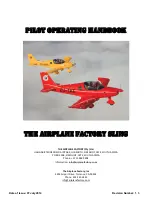
Flight and Operational Manual
TL- 96 STAR s/n 99 S 25
Notice! The information contained in this document is for reference and information only.
The pilot is the final and only responsible party for the safe operation of this aircraft.
- 7 -
The pilotage of the airplane is duplicated, arranged classically. Flowing elevator
is controlled by the rod, direction indicator by wires. Ailerons and lifting flaps are controlled
by rods.
The wing is rectangle all composite with main and helpful longeron from glassy laminate,
The dust-cover is sandwiched. Lifting flaps are made into two-positions.
Flowing elevator is also composite, it is supplied with aggravating tab, and through the tab
is also provided longitudinal trim of the airplane. The conception of the flowing elevator
contributes to the low aerodynamic drag of the airplane. Producer of the fuselage is the
company TL Ultralight.
1.2.2. Fuel system
The fuel system constitutes by the integrated composite fuel tank in the fuselage. It is fitted
out with fuel meter, distribution, closing cock, filter and mechanical fuel pump. These all
belong to the engine types 912 and 912s. At engine 914 Turbo the supply is ensured
electrically.
The fuel tank is equipped with lockable lid placed on the front right side of the fuselage.
The producer of the fuel system is also the company TL Ultralight.
1.2.3. Propeller
It is possible to use stationary and adjustable propeller. The description of the propeller is
provided with your airplane and is included in the instruction for assembly and maintenance
of the propeller which is a part of the delivery.
1.2.4. Engine
Most used engines are types Rotax 912, 912S and 914, which ensure the airplane excellent
dynamic and flying properties. Engines Rotax 912, 912S and 914 are four-stroke four-
cylinder engines the type boxer. The cylinder head is cooled by the refrigerating liquid and
the cylinders are cooled down by air.
There is a reductor at the engine, the engine has two carburettors. Detail information are
enclosed in the instruction for using the engine.
ATTENTION!
None of the enclosed engines are certificated as a flying engines. Even though
maximum attention is paid during the procedure of the engine, misfire of the
engine can occur at any time. The only pilot is responsible for the consequences.
The obligation of the pilot which is written down in the rule UL1 is to fly at all
conditions the way to be able to glide and land safely to preselected area in case
of misfire of the engine.




































